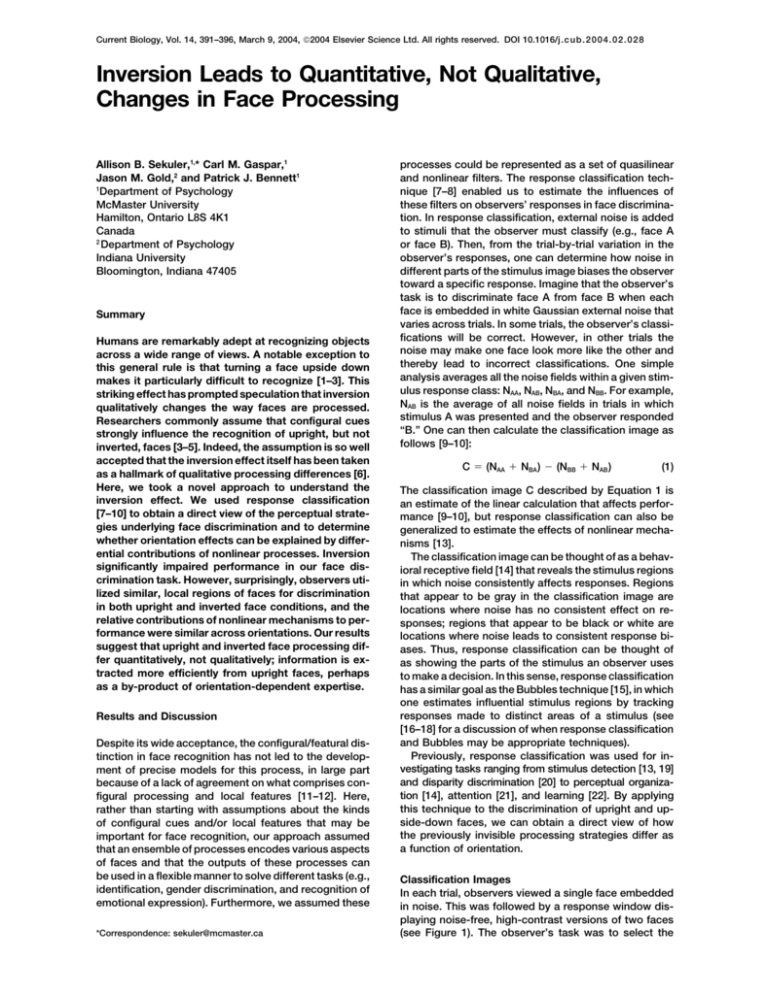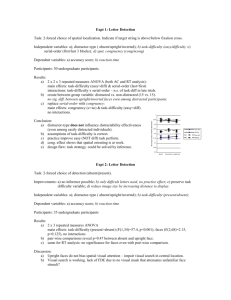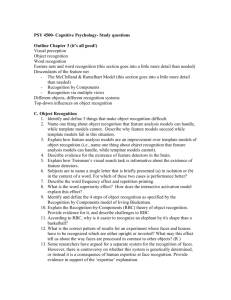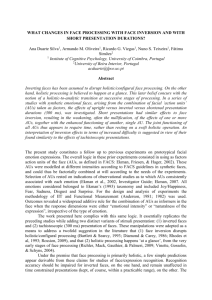
Current Biology, Vol. 14, 391–396, March 9, 2004, 2004 Elsevier Science Ltd. All rights reserved. DOI 10.1016/j.cub.2004.02.028
Inversion Leads to Quantitative, Not Qualitative,
Changes in Face Processing
Allison B. Sekuler,1,* Carl M. Gaspar,1
Jason M. Gold,2 and Patrick J. Bennett1
1
Department of Psychology
McMaster University
Hamilton, Ontario L8S 4K1
Canada
2
Department of Psychology
Indiana University
Bloomington, Indiana 47405
Summary
Humans are remarkably adept at recognizing objects
across a wide range of views. A notable exception to
this general rule is that turning a face upside down
makes it particularly difficult to recognize [1–3]. This
striking effect has prompted speculation that inversion
qualitatively changes the way faces are processed.
Researchers commonly assume that configural cues
strongly influence the recognition of upright, but not
inverted, faces [3–5]. Indeed, the assumption is so well
accepted that the inversion effect itself has been taken
as a hallmark of qualitative processing differences [6].
Here, we took a novel approach to understand the
inversion effect. We used response classification
[7–10] to obtain a direct view of the perceptual strategies underlying face discrimination and to determine
whether orientation effects can be explained by differential contributions of nonlinear processes. Inversion
significantly impaired performance in our face discrimination task. However, surprisingly, observers utilized similar, local regions of faces for discrimination
in both upright and inverted face conditions, and the
relative contributions of nonlinear mechanisms to performance were similar across orientations. Our results
suggest that upright and inverted face processing differ quantitatively, not qualitatively; information is extracted more efficiently from upright faces, perhaps
as a by-product of orientation-dependent expertise.
Results and Discussion
Despite its wide acceptance, the configural/featural distinction in face recognition has not led to the development of precise models for this process, in large part
because of a lack of agreement on what comprises configural processing and local features [11–12]. Here,
rather than starting with assumptions about the kinds
of configural cues and/or local features that may be
important for face recognition, our approach assumed
that an ensemble of processes encodes various aspects
of faces and that the outputs of these processes can
be used in a flexible manner to solve different tasks (e.g.,
identification, gender discrimination, and recognition of
emotional expression). Furthermore, we assumed these
*Correspondence: sekuler@mcmaster.ca
processes could be represented as a set of quasilinear
and nonlinear filters. The response classification technique [7–8] enabled us to estimate the influences of
these filters on observers’ responses in face discrimination. In response classification, external noise is added
to stimuli that the observer must classify (e.g., face A
or face B). Then, from the trial-by-trial variation in the
observer’s responses, one can determine how noise in
different parts of the stimulus image biases the observer
toward a specific response. Imagine that the observer’s
task is to discriminate face A from face B when each
face is embedded in white Gaussian external noise that
varies across trials. In some trials, the observer’s classifications will be correct. However, in other trials the
noise may make one face look more like the other and
thereby lead to incorrect classifications. One simple
analysis averages all the noise fields within a given stimulus response class: NAA, NAB, NBA, and NBB. For example,
NAB is the average of all noise fields in trials in which
stimulus A was presented and the observer responded
“B.” One can then calculate the classification image as
follows [9–10]:
C ⫽ (NAA ⫹ NBA ) ⫺ (NBB ⫹ NAB )
(1)
The classification image C described by Equation 1 is
an estimate of the linear calculation that affects performance [9–10], but response classification can also be
generalized to estimate the effects of nonlinear mechanisms [13].
The classification image can be thought of as a behavioral receptive field [14] that reveals the stimulus regions
in which noise consistently affects responses. Regions
that appear to be gray in the classification image are
locations where noise has no consistent effect on responses; regions that appear to be black or white are
locations where noise leads to consistent response biases. Thus, response classification can be thought of
as showing the parts of the stimulus an observer uses
to make a decision. In this sense, response classification
has a similar goal as the Bubbles technique [15], in which
one estimates influential stimulus regions by tracking
responses made to distinct areas of a stimulus (see
[16–18] for a discussion of when response classification
and Bubbles may be appropriate techniques).
Previously, response classification was used for investigating tasks ranging from stimulus detection [13, 19]
and disparity discrimination [20] to perceptual organization [14], attention [21], and learning [22]. By applying
this technique to the discrimination of upright and upside-down faces, we can obtain a direct view of how
the previously invisible processing strategies differ as
a function of orientation.
Classification Images
In each trial, observers viewed a single face embedded
in noise. This was followed by a response window displaying noise-free, high-contrast versions of two faces
(see Figure 1). The observer’s task was to select the
Current Biology
392
Figure 1. Face Stimuli and Ideal Observer Templates
Stimuli were one pair of female faces (A and B) and one pair of male faces (D and E). The most discriminative regions within each face pair
are shown in the ideal observer classification images (C and F).
face presented in each trial. The combination of two
factors (upright vs. inverted and male vs. female faces)
led to four conditions, which were tested in different
blocks. Contrast detection thresholds were determined
for 71% correct performance, and noise fields from each
trial were stored to derive classification images (see
Experimental Procedures for details). Inverted face discrimination required 53% more contrast than upright
face discrimination; root mean square (RMS) contrast
thresholds for upright and inverted faces were 0.0172
and 0.0264, respectively [t(8) ⫽ 3.20, p ⬍ 0.05]. Thus,
despite the fact that only two faces were shown in each
condition, observers exhibited significant inversion effects similar to those expected from experiments with
multiple faces. This result indicates that it is unlikely
that observers were treating the stimuli like random
patches of dark and light in an image-matching task
because one would not expect, a priori, to find an inversion effect when simply matching one meaningless texture to another.
Visual inspection of the classification images (Figure
2) suggests that only highly localized regions of the
stimulus, primarily around the eyes and eyebrows, have
consistently affected observers’ responses. Although it
may seem surprising that such a restricted region would
influence face perception, this result is consistent with
recent results from studies regarding face perception
[23–25]. The region around the eyes and eyebrows is
also the region in which our face stimuli differ most from
one another and therefore contains most of the available
discrimination information. Thus, if observers can encode information from only a portion of the face, then
the most efficient strategy for our stimulus set and task
would be to focus on the eyes and eyebrows.
To quantify the analyses, we determined both the
number of pixels that correlated significantly with an
observer’s response in each classification image and
the normalized cross correlation of the observer’s classification image with the classification image for an ideal
discriminator. For our task, the ideal classification image
was simply the pixel-by-pixel difference between the
two faces being discriminated. The number of significant
pixels indicates how much of the stimulus observers
used in each condition, whereas the correlation analysis
indicates how efficiently observers used that information. As seen in Figure 3, the number of significant pixels
did not vary consistently with stimulus orientation [t(8) ⫽
1.61, not significant] and those pixels generally were
confined to the eye/brow region (blue rectangles, as
described in Figure 2). Across all observers and face
gender, an average of 75.4% and 76.8% of the significant pixels fell within this region for upright and inverted
faces, respectively. However, the correlation between
real and ideal classification images was always higher
for upright stimuli; correlations were on average 1.72
times greater for upright faces than for inverted faces
[t(8) ⫽ 8.29, p ⬍ 0.0001]. Thus, although observers generally used about the same number of highly localized
Face Inversion: A Quantitative Processing Change
393
Figure 2. Smoothed Classification Images
Sample classification images for female faces
(ALG [A and B]) and male faces (KAT [C and
D]). The left column shows results for upright
faces, and the right column shows results for
inverted faces (rotated 180⬚). For computation of smoothed classification images, raw
classification images were convolved with a
5 ⫻ 5 convolution kernel (the outer product
of [1, 2, 3, 2, 1]T). Blue rectangles show the
71 ⫻ 29 pixel region surrounding the eyes
and eyebrows in the original face images
(12.6% of the total pixels).
pixels in each case, the information contained in those
pixels was used much more efficiently for upright faces
than for inverted faces.
Nonlinear Contributions
Our interpretation of classification images, as defined
by Equation 1, is limited by the fact that the technique
reveals only the linear association between each pixel’s
contrast and the observer’s responses and is not sensitive to nonlinearities. However, the contribution of nonlinearities can be estimated indirectly from classification
images [26]. If, in each trial, the decision of an observer is
affected only by linear mechanisms, then the observer’s
absolute efficiency (i.e., measured performance relative
to the best possible performance of an ideal discriminator) can be predicted from the obtained classification
image. If absolute efficiency is higher than the predicted
value, then nonlinear mechanisms whose influence is
not captured by the classification image must have contributed to the observer’s behavior. Figure 4 shows the
relationship between predicted and obtained values of
absolute efficiency for upright and inverted conditions.
The results point to two important conclusions. First,
there is a strong relationship between predicted and
obtained absolute efficiencies; observed efficiency was
correlated with predicted efficiency [r2 ⫽ 0.76], and the
addition of face orientation as an additional, binary predictor variable did not significantly improve the fit of the
regression model. Thus, variation in the structure within
classification images is strongly correlated with differences in thresholds obtained with upright and inverted
faces. Second, observed efficiency was slightly but con-
sistently greater than predicted efficiency, thereby suggesting that nonlinear processes contributed to performance in our task. Interestingly, the fact that deviations
from the predicted efficiency were similar for upright
and inverted faces suggests that the contributions to
performance that can be attributed to such nonlinear
processes were similar in the two conditions (although
it remains possible that different nonlinear processes
are involved for faces viewed at different orientations).
Conclusions
Like previous researchers, we found that observers were
more sensitive to differences between upright faces
than between inverted faces. Such a result is typically
interpreted to mean that upright faces are processed
configurally, whereas the processing of upside-down
faces is based primarily on features. However, our results do not support the conclusion that qualitatively
distinct modes of processing are used in the two conditions. In our experiments, performance differences between upright and inverted faces were correlated with
the structure contained in linear classification images,
and observers used highly localized regions near the
eyes to discriminate faces at both orientations. Although
nonlinear mechanisms contributed to performance, the
magnitude of this contribution was small and similar
for both upright and inverted faces. Overall, our results
suggest that the primary difference between processing
upright and inverted faces is quantitative rather than
qualitative. Discriminative regions are processed more
efficiently in upright faces than in upside-down faces.
This view differs from the standard view of configural
Current Biology
394
Figure 3. Significant Pixels and Cross-Correlation Results
Statistically significant pixels from classification images derived across all trials for all
observers for (A) female and (B) male faces
superimposed on a low-contrast version of
the ideal observer classification image. Red
pixels indicate significance (p ⬍ 0.001) for
upright faces, green for inverted, and yellow
for both. (C) Correlations between human and
ideal classification images differed significantly
across orientation. Open red bars show results for upright faces, filled green bars for
inverted. Missing bars represent values at
(SKH) or below (GBN, ⫺0.002) the abscissa.
(D) There were no consistent differences in
the number of significant pixels across orientation. Symbols are as in (C). The missing bar
represents a value at the abscissa.
versus part-based processing, but it is consistent with
results from some recent behavioral and neuroimaging
studies. For example, inversion effects have been found
for the isolated eye/brow region of the face [24, 27].
These results suggest that the inversion effect does
not require global processing across the entire face.
Observers can also recognize upright faces in the presence of large geometric distortions, suggesting that face
processing strategies are not based on the relative positions of discrete facial features in any simple way [28].
In addition, studies with fMRI show preferential activation in the so-called fusiform face area (FFA) for both
upright and inverted faces compared to other objects
such as houses [29]. All of these results support the idea
that upright and inverted faces engage similar neural
mechanisms. Although it is possible that different populations of neurons lead to these responses for upright
and inverted faces, it is equally possible that both types
of stimuli lead to activation of the same expertise-related
mechanisms [30–31]. In this latter context, the advantage for processing upright faces may simply be a byproduct of relative expertise levels. For example, previous researchers have shown that perceptual learning
can be quite specific (e.g., to stimulus orientation [32]),
and past research has also shown that perceptual learning increases processing efficiency [22, 33]. Throughout
our lives, we certainly have more experience recognizing
upright faces than upside-down faces, and this increased experience may lead to increased processing
efficiency.
It remains an empirical question whether our approach can account for other results typically explained
in terms of configural processing for upright faces (e.g.,
the Thatcher Illusion [34], the Composite Effect [35]).
For example, the failure to recognize grotesque expressions in inverted, Thatcherized faces may be due to
decreased ability to extract relevant emotional information from inverted faces (similar to the decreased ability
to extract relevant identity information from inverted
faces). However, it also remains possible that nonlinearities play a bigger role in such tasks and, more generally,
that nonlinear processes are more important at suprathreshold signal-to-noise ratios.
Experimental Procedures
Data were collected in two laboratories via slightly different methods
(versions A and B). However, the results were qualitatively and quan-
Face Inversion: A Quantitative Processing Change
395
pants completed 10,000 trials in each condition, and each classification image was based on all 10,000 trials. There were 4–6 sessions
per condition (500–2500 trials per session). Throughout the session,
stimulus contrast was adjusted with a staircase procedure so that
response accuracy remained at approximately 71% correct. Results
from one observer’s male conditions are not included in the analyses
because a computer error led to the presentation of incorrect contrast values in those conditions.
Version B
Two observers were tested with female faces and two with male
faces. Each observer was tested with both upright and inverted
faces. All observers received several thousand practice trials in the
face discrimination tasks before the main experiment. Each testing
session consisted of 2150 trials. During the first 150 trials, stimulus
contrast was adjusted with a staircase procedure so that the contrast needed to produce 71% correct responses could be estimated.
Stimulus contrast remained at this value for the session’s remaining
2000 trials, of which results were used to calculate the classification
image. Each classification image was based on a total of 10,000
trials.
Acknowledgments
Figure 4. Relationship between Predicted and Obtained Absolute
Efficiencies
Each point represents results from a single observer’s classification
image for upright (open red) and inverted (filled green) face discrimination. Observed efficiency was strongly correlated with predicted
efficiency, and the relationship was constant across orientations.
titatively similar and so were combined. Both versions used Matlab
with the Psychophysics Toolbox extensions [36, 37] to control stimulus presentation and response collection.
Stimuli
Each face was 99 pixels high and ranged from 62 to 90 pixels wide.
Average luminance was 13.3 cd/m2. Screen resolution was always
640 ⫻ 480 pixels, but pixel size was approximately 2.5 and 4.2
minarc for versions A and B, respectively. At a viewing distance of
100 cm, the height of each face subtended 4.1⬚ or 6.9⬚, and the
width ranged from 2.6⬚ to 3.7⬚ or 4.3⬚ to 6.2⬚ for versions A and B,
respectively. Each face was centered within a 128 ⫻ 128 pixel array
(5.3⬚ ⫻ 5.3⬚ or 8.9⬚ ⫻ 8.9⬚ for versions A and B, respectively). Additional details about stimulus generation can be found elsewhere
[23]. For derivation of classification images, static, white Gaussian
noise was added to each face (noise root-mean-square contrast:
0.14%). A new noise field covering the entire stimulus was generated
in each trial. Half of the blocks contained two female faces, and half
of the blocks contained two male faces; within each block, the face
orientation was held constant, and two different conditions were
tested for each face gender: upright and inverted.
Procedure
Three females (average age: 21 yr) participated in version A; one
female and three males (average age: 24 yr) participated in version
B. All observers except C.M.G. were naı̈ve in regards to the purpose
of the experiment and were unfamiliar with the face stimuli at the
beginning of the experiment. All observers had normal or corrected
to normal vision. In each trial, one of two faces was randomly selected as the target. Each trial consisted of an initial 1 s fixation on
a small spot, followed by a face plus noise stimulus displayed for
500 ms. Finally, a selection window containing noise free, highcontrast versions of two faces was displayed. The subject indicated
which face had served as the stimulus by clicking on that face with
a computer mouse. The selection window remained visible until
this response, and response accuracy was indicated by auditory
feedback.
Version A
Orientation (upright and inverted) and gender (male and female) of
face stimuli were crossed in a within-subjects design. All partici-
This research was supported by grants from the Natural Sciences
and Engineering Research Council of Canada, the Canada Research
Chair Council, the Canada Foundation for Innovation, and the Ontario Innovation Trust. We thank Richard Murray, Robert Sekuler,
Denis Pelli, and an anonymous reviewer for their many helpful suggestions and comments.
Received: November 13, 2003
Revised: January 20, 2004
Accepted: January 20, 2004
Published: March 9, 2004
References
1. Yin, R.K. (1969). Looking at upside-down faces. J. Exp. Psychol.
81, 141–145.
2. Diamond, R., and Carey, S. (1986). Why faces are and are not
special: an effect of expertise. J. Exp. Psychol. Gen. 115,
107–117.
3. Valentine, T. (1988). Upside-down faces: a review of the effect
of inversion upon face recognition. Br. J. Psychol. 79, 471–491.
4. Tanaka, J.W., and Farah, M.J. (1993). Parts and wholes in face
recognition. Q. J. Exp. Psychol. A 46, 225–245.
5. Murray, J.E., Yong, E., and Rhodes, G. (2000). Revisiting the
perception of upside-down faces. Psychol. Sci. 11, 492–496.
6. Reed, C., Stone, V.E., Bozova, S., and Tanaka, J. (2003). The
body-inversion effect. Psychol. Sci. 14, 302–308.
7. Ahumada, A., Jr., and Lovell, J. (1971). Stimulus features in
signal detection. J. Acoust. Soc. Am. 49, 1751–1756.
8. Beard, B.L., and Ahumada, A.J. (1988). A technique to extract
relevant image features for visual tasks. In SPIE Proceedings:
vol. 3299. Human Vision and Electronic Imaging III, B.E. Rogowitz, and T. N. Pappas T.N., eds. (Bellingham, WA: SPIE), pp.
79–85.
9. Murray, R.F., Bennett, P.J., and Sekuler, A.B. (2002). Optimal
methods for calculating classification images: weighted sums.
J. Vis. 2, 79–104, http://journalofvision.org/2/1/6/, doi:10.1167/
2.1.6.
10. Ahumada, A.J. (2002). Classification image weights and internal
noise level estimation. J. Vis. 2, 121–131, http://journalofvision.
org/2/1/8/, doi:10.1167/2.1.8.
11. Farah, M.J., Wilson, K.D., Drain, M., and Tanaka, J.N. (1998).
What is “special” about face perception? Psychol. Rev. 105,
482–498.
12. Maurer, D., Grand, R.L., and Mondloch, C.J. (2002). The many
faces of configural processing. Trends Cogn. Sci. 6, 255–260.
13. Neri, P., and Heeger, D.J. (2002). Spatiotemporal mechanisms
for detecting and identifying image features in human vision.
Nat. Neurosci. 5, 812–816.
Current Biology
396
14. Gold, J.M., Murray, R.F., Bennett, P.J., and Sekuler, A.B. (2000).
Deriving behavioural receptive fields for visually completed contours. Curr. Biol. 10, 663–666.
15. Gosselin, F., and Schyns, P.G. (2001). Bubbles: a technique to
reveal the use of information in recognition tasks. Vision Res.
41, 2261–2271.
16. Murray, R.F., and Gold, J.M. (2004). Troubles with bubbles. Vision Res. 44, 461–470.
17. Gosselin, F., and Schyns, P.G. (2004). No troubles with bubbles:
a reply to Murray and Gold. Vision Res. 44, 471–477.
18. Murray, R.F., and Gold, J.M. (2004). Reply to Gosselin and
Schyns. Vision Res. 44, 479–482.
19. Solomon, J.A. (2002). Noise reveals visual mechanisms of detection and discrimination. J. Vis. 2, 105–120, http://journalofvision.
org/2/1/7, doi:10.1167/2.1.7.
20. Neri, P., Parker, A.J., and Blakemore, C. (1999). Probing the
human stereoscopic system with reverse correlation. Nature
401, 695–698.
21. Eckstein, M.P., Shimozaki, S.S., and Abbey, C.K. (2002). The
footprints of visual attention in the Posner cueing paradigm
revealed by classification images. J. Vis. 2, 25–45, http://
journalofvision.org/2/1/3/, doi:10.1167/2.1.3.
22. Gold, J., Sekuler, A.B., and Bennett, P.J. Characterizing perceptual learning with external noise. Cog. Sci., in press.
23. Gold, J., Bennett, P.J., and Sekuler, A.B. (1999). Identification
of band-pass filtered letters and faces by human and ideal
observers. Vision Res. 39, 3537–3560.
24. Leder, H., Candrian, G., Huber, O., and Bruce, V. (2001). Configural features in the context of upright and inverted faces. Perception 30, 73–83.
25. Sadr, J., Jarudi, I., and Sinha, P. (2003). The role of eyebrows
in face recognition. Perception 32, 285–293.
26. Murray, R.M. (2002). Perceptual organization and the efficiency
of shape discrimination. Ph.D. Thesis, University of Toronto,
Toronto, Canada.
27. Rakover, S.S., and Teucher, B. (1997). Facial inversion effects:
parts and whole relationship. Percept. Psychophys. 59,
752–761.
28. Hole, G.J., George, P.A., Eaves, K., and Rasek, A. (2002). Effects
of geometric distortions on face-recognition performance. Perception 31, 1221–1240.
29. Kanwisher, N., Tong, F., and Nakayama, K. (1998). The effect
of face inversion on the human fusiform face area. Cognition
68, B1–11.
30. Tarr, M.J., and Gauthier, I. (2000). FFA: a flexible fusiform area for
subordinate-level visual processing automatized by expertise.
Nat. Neurosci. 3, 764–769.
31. Gauthier, I., Curran, T., Curby, K.M., and Collins, D. (2003). Perceptual interference supports a non-modular account of face
processing. Nat. Neurosci. 6, 428–432.
32. Gauthier, I., Williams, P., Tarr, M.J., and Tanaka, J. (1998). Training ‘greeble’ experts: a framework for studying expert object
recognition processes. Vision Res. 38, 2401–2428.
33. Gold, J., Bennett, P.J., and Sekuler, A.B. (1999). Signal but not
noise changes with perceptual learning. Nature 402, 176–178.
34. Thompson, P. (1980). Margaret Thatcher: a new illusion. Perception 9, 483–484.
35. Young, A.W., Hellawell, D., and Hay, D.C. (1987). Configurational
information in face perception. Perception 16, 747–759.
36. Pelli, D.G. (1997). The VideoToolbox software for visual psychophysics: transforming numbers into movies. Spat. Vis. 10,
437–442.
37. Brainard, D.H. (1997). The Psychophysics Toolbox. Spat. Vis.
10, 443–446.









